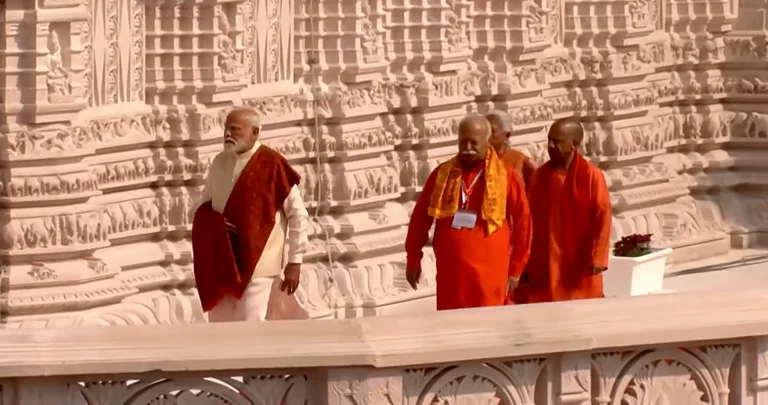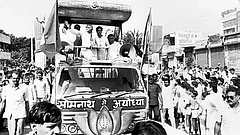On Friday December 23 1949, not too long after Independence, the Shri Rām Janmabhoomi dispute resurfaced when Rām Lallā idols mysteriously appeared in the Babri structure at Ayodhya in the dead of the night. That day was destined to become a starting point for a long drawn-out legal battle and a protracted public movement of unprecedented scale in the history of free India. Soon a small group of devotees chanting Prakat Kripala Deen Dayala arrived on the scene leading to commotion in the wee hours of the morning, a time when usually it was all quiet in Ayodhya particularly at the Babri structure.
For the believers the emergence of Rām Lallā was a divine phenomenon. A surprise statement by Abdul Barkat, a Muslim police constable on duty at the Police outpost at Rām Janmabhoomi on the night between 22 and 23 December 1949, made before a magistrate later further strengthened the devotees’ belief of the divinity of the episode that midnight. In Sri Ram Janma Bhumi: Historical and Legal Perspective, Justice Deoki Nandan has provided this version of Abdul Barkat’s testimony before a court,
“While on duty that night, he saw a flash of Divine Light inside the Babari Masjid. Gradually that light became golden and in that he saw the figure of a very beautiful godlike child of four or five years, the likes of which he had never seen before in his life. The sight sent him into a trance, and when he recovered his senses, he found that the lock on the main gate (of the mosque) was lying broken and a huge crowd of Hindus had entered the building and were performing the aarti of the Idol placed 66 // Tryst with Ayodhya : Decolonisation of India on a singhasan and reciting: Bhaye Prakat Kripala Deen Dayala.” (The phrase Bhaye Prakat Kripala Deen Dayala meaning “God has manifested himself.”)

Sceptics may term Abdul Barkat’s account of the events as weird, a figment of the imagination of a possibly disturbed mind or a simple case of hallucination. However, any establishment responsive to public sensibilities would normally deal with such a situation with empathy and compassion, transcending legal and procedural technicalities. Abdul, a Muslim by faith, had no obvious motive to invent such a tale. He narrated what he thought he had experienced or seen. His recall of the happenings that December night could also be described as one of those ‘rare supernatural phenomena’ that defy logic and known laws of science. Although even if possibly Abdul was subconsciously influenced by some of the folklore in circulation in Ayodhya and its neighbouring areas about the conflicts and battles fought between warring groups to reclaim the Ramjanmabhoomi site in the not-too-distant past, independent of Abdul’s story countless Hindus anyway believed that the disputed site was the birthplace of Shri Rām and that He indeed had put in miraculous appearance that fateful night.
Reports filed by civil and police officials dealing with the situation arising out of the appearance of the Rām Lallā idols record that there was huge excitement among the locals over this development and that they were convinced about the veracity of the miraculous episode. The famous French philosopher Voltaire was right when he said, “faith consists in believing when it is beyond the power of reason to believe.”
Hindus Never Viewed The Babri Structure As A Mosque, But As A Symbol Of Humiliation Imposed By A Ruthless Victor On The Hapless Vanquished.
In civilised societies normally no one questions issues involving faith, particularly when believers are in substantial numbers. Global history is replete with instances where faith has overshadowed all other considerations. Not surprisingly an overwhelming number of Hindus never viewed the Babri structure as a mosque, a place of worship, but as a symbol of humiliation imposed by a ruthless victor on the hapless vanquished; umpteen battles had been fought and lives lost in efforts to reclaim the janmabhoomi site. These were neither struggles for a piece of real estate or a title suite nor a case of Islamophobia either; Abdul had no problem with the numerous other mosques that dotted Ayodhya, Faizabad and the neighbouring districts.
In addition to the history of an uninterrupted saga of conflicts to reclaim the janmabhoomi site spanning centuries there is a plethora of travelogues left behind by footloose foreigners recording its existence in Ayodhya and its subsequent destruction by Islamic zealots. How were Hindus supposed to prove that Shri Rām was born at that very place? Did one seriously expect the believing Hindus to produce Shri Rām’s birth certificate or some revenue records to establish that it was the very site on which King Dashrath’s palace once stood where Shri Rām was born and was now occupied by the Babri structure? That Shri Rām was born on that very site had been a matter of faith for the populace since times immemorial. Thus the events at the Ramjanmabhoomi structure on the fateful night of 22 December 1949 were in a way the culmination of developments that began in Ayodhya some months following independence.
MORE FROM THIS ISSUE
Even as the history of skirmishes and battles waged to free the Ramjanmabhoomi site was long, a quiet had prevailed for some decades. Earlier the East India Company had managed to annex valorous Punjab after the demise of Maharaja Ranjit Singh in 1939. The First War of Independence or the ‘sepoy mutiny’ in British parlance of 1857 too had been crushed. The following year in 1958 a group of Nihang Sikhs wandered into Ayodhya and probably took an impromptu decision to free Ramjanmabhoomi from Muslim control. They took over the structure resulting in the recording of the first legal case in the Ayodhya dispute that year.
Balbir Punj is a social and political commentator.
The book ‘Tryst With Ayodhya’ has been published by Kitabvale. The excerpt is being carried with permission.





























